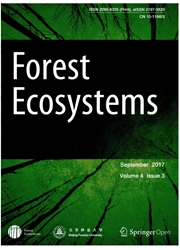

 中文摘要:
中文摘要:
亚洲 longhorned 甲壳虫(白长袍的) , Anoplophora glabripennis (Motschulsky ) 是硬木树的杂食的木头 borer。以便很好理解 A 的产卵离子偏爱。glabripennis 从不同幼虫的主人树种类出现,我们在这个领域里选择了五普通主人树种并且评估了它的产卵离子偏爱。五宿主树种是 Acer 否定松开(一) , Salix matsudana f。lobato-glandulosa (SM ) , Populus nigra L。var。thevestina (Dode ) 豆子(PN ) , P。simonii × P。金字塔形是 cv。歌剧 8277 (PS ) 并且 P。白长袍的 var。金字塔形(PA ) 。结果证明那个成年人急速移动从这出现五树种几乎有一样的产卵离子现象。除了那些从 PS 出现,所有成年甲壳虫咀嚼了最高潜在的地点并且生了大多数鸡蛋在上一树。从新兴的成年甲壳虫一, PN, PS 和 PA 没咀嚼任何地点也不在 PA 树上生任何鸡蛋。这些结果显示出那成年 A。从五主人树种出现的 glabripennis 没在这块地里为他们的幼虫的主人树种类显示出任何清楚的产卵离子偏爱,但是他们确实介绍了最明显的偏爱为一 and 为 PA 的最低偏爱。
 英文摘要:
英文摘要:
The Asian longhorned beetle (ALB), Anoplophora glabripennis (Motschulsky) is a polyphagous woodborer of hardwood trees. In order to well understand the oviposition preference of A. glabripennis emerging from different larval host tree species, we selected five common host tree species in the field and evaluated its oviposition preferences. The five host tree species are Acer negundo (AN), Salix matsudana f. lobato-glandulosa (SM), Populus nigra L. var. thevestina (Dode) Bean (PN), P. simonii × P. pyramidalis cv. Opera 8277 (PS) and P. alba var. pyramidalis (PA). Results show that adult beetles emerging from these five tree species almost have the same oviposition phenomenon. All adult beetles, except those emerging from PS, chewed the highest potential sites and laid most eggs on AN trees. Adult beetles emerging from AN, PN, PS and PA did not chew any sites nor laid any eggs on PA trees. These results showed that adult A. glabripennis emerging from the five host tree species did not show any clear oviposition preference for their larval host tree species in the field but they did present the most obvious preference for AN and the lowest preference for PA.
 同期刊论文项目
同期刊论文项目
 同项目期刊论文
同项目期刊论文
 期刊信息
期刊信息
